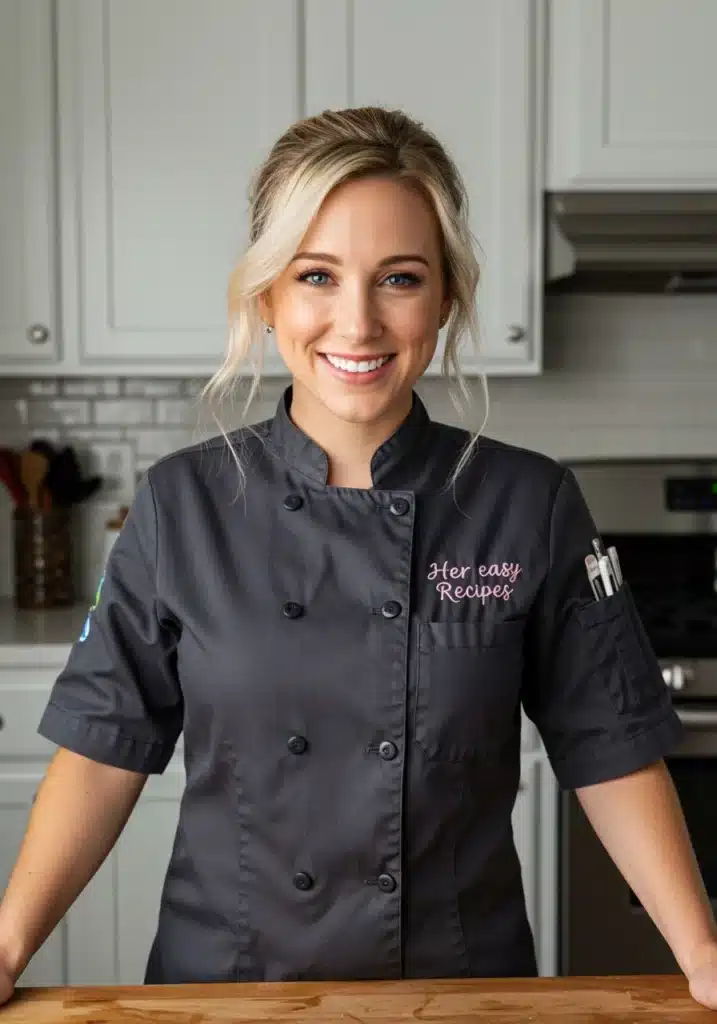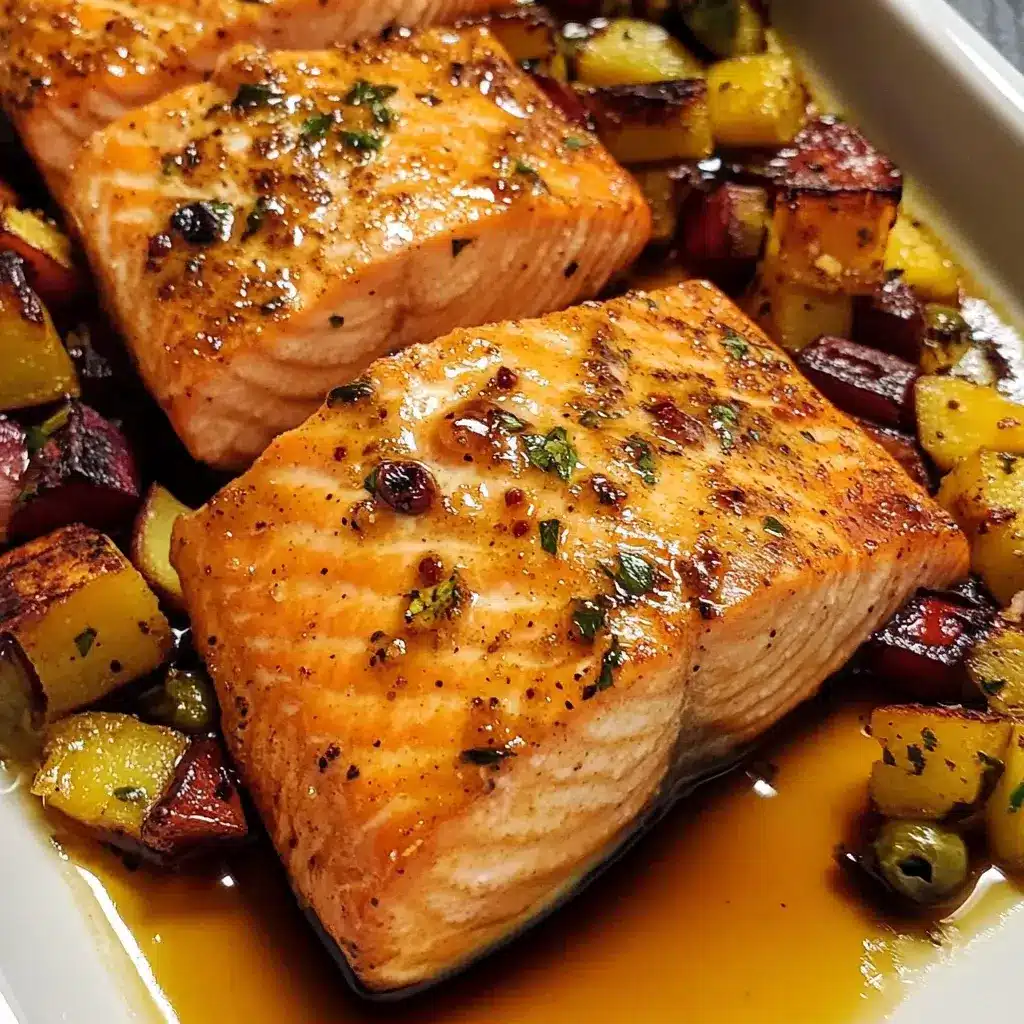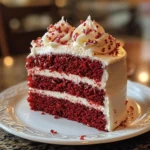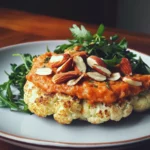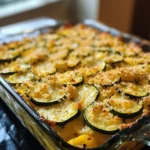If there is one dish that I believe perfectly encapsulates the idea of “effortless elegance,” it is this Maple Mustard Salmon. For years, I was intimidated by the thought of cooking fish at home. I had this ingrained fear of overcooking it into a dry, sad state or, conversely, undercooking it. That all changed with this recipe. It was born on a crisp autumn evening when I wanted something healthy and special but had minimal time and energy. I rummaged through my pantry and fridge, pulling out the trusty trio of pure maple syrup, Dijon mustard, and whole grain mustard. I whisked them together with a little soy sauce for depth and garlic for a savory punch. As I brushed the glistening, amber-hued glaze over a beautiful salmon fillet, I had a feeling this was going to be good. Twenty minutes later, I pulled a masterpiece from the oven. The top was perfectly caramelized, the edges slightly crispy, and the aroma was an intoxicating blend of sweet, tangy, and savory. The first bite was a revelation—impossibly moist, flaky salmon that melted in my mouth, with a sauce so perfectly balanced it was practically symphonic. My family, usually my toughest critics, were silent for a moment before declaring it the “best salmon ever.” Now, it’s my secret weapon. It’s the dish I make for last-minute dinner guests, the one I turn to for a quick and luxurious weeknight meal, and the recipe that proved to me that anyone can cook fish perfectly.
The Ultimate Maple Mustard Salmon: Complete Ingredients
The magic of this recipe lies in its simplicity and the powerful synergy between just a handful of high-quality ingredients. Each component is carefully chosen to build a complex, layered flavor profile that tastes like it took hours to develop, not minutes.
- Salmon Fillet: 1 large, 2-pound fillet. A center-cut fillet is ideal as it has a more even thickness, ensuring consistent cooking. You can use skin-on or skin-off salmon; skin-on has the added benefit of providing a barrier that helps keep the fish incredibly moist.
- Pure Maple Syrup: ¼ cup. It is crucial to use 100% pure maple syrup, not breakfast or pancake syrup. The pure syrup provides a clean, nuanced sweetness and caramelizes beautifully.
- Dijon Mustard: 2 tablespoons. This provides a sharp, tangy, and slightly spicy backbone to the sauce, cutting through the richness of the salmon.
- Whole Grain Mustard: 2 tablespoons. This adds a wonderful, poppy texture and a milder, more rustic mustard flavor that complements the Dijon perfectly.
- Low-Sodium Soy Sauce or Tamari: 1 tablespoon. This is the secret umami weapon, adding a deep, savory saltiness that balances the sweetness of the maple syrup. Use tamari for a gluten-free option.
- Garlic: 3 cloves, minced. Freshly minced garlic provides the best aromatic, savory flavor.
- Olive Oil: 1 tablespoon. This helps the glaze spread and prevents the salmon from sticking.
- Salt and Freshly Ground Black Pepper: To taste.
- Fresh Parsley or Dill: 2 tablespoons, chopped, for garnish. This final touch adds a burst of fresh, herbaceous flavor that brightens the entire dish.
Step-by-Step Instructions for Perfect Baked Salmon
Follow these detailed instructions to achieve a perfectly cooked, flaky, and flavorful salmon fillet every single time. The process is remarkably simple, with the oven doing most of the work.
Step 1: Preheat and Prepare
First, position a rack in the center of your oven and preheat it to 400°F (200°C). Line a large, rimmed baking sheet with parchment paper or aluminum foil. This step is not just for preventing the salmon from sticking; it makes cleanup an absolute breeze. Take the salmon fillet out of the refrigerator and pat it completely dry on all sides with paper towels. This is a critical step, as a dry surface will allow the salmon to roast and the glaze to adhere properly, rather than just steaming.
Step 2: Make the Maple Mustard Glaze
In a small bowl, whisk together the ¼ cup of pure maple syrup, 2 tablespoons of Dijon mustard, 2 tablespoons of whole grain mustard, 1 tablespoon of soy sauce (or tamari), the 3 minced garlic cloves, and the 1 tablespoon of olive oil. Continue whisking until the glaze is smooth and well combined.
Step 3: Season and Glaze the Salmon
Place the dry salmon fillet on the prepared baking sheet, skin-side down if it has skin. Season the top of the fillet generously with salt and freshly ground black pepper. Spoon or brush about two-thirds of the maple mustard glaze evenly over the top and sides of the salmon. Reserve the remaining one-third of the glaze for later.
Step 4: Bake to Flaky Perfection
Place the baking sheet in the preheated oven and bake for 12-15 minutes. The exact cooking time will depend on the thickness of your salmon fillet. You’ll know it’s done when the flesh is opaque and flakes easily when gently pressed with a fork at the thickest part. For precise results, you can use an instant-read thermometer; the USDA recommends an internal temperature of 145°F, but many chefs and home cooks prefer to pull the salmon out between 130°F and 135°F for a moister, more tender result, as it will continue to cook slightly from residual heat after being removed from the oven.
Step 5: The Final Caramelization (Optional but Highly Recommended)
For that beautiful, bubbly, and caramelized top that makes this dish truly special, you can use the broiler for the final minute of cooking. Remove the salmon from the oven, brush the remaining reserved glaze over the top, and switch your oven setting to a high broil. Return the salmon to the oven on the center rack and broil for 1-2 minutes. Watch it like a hawk during this step, as the sugars in the maple syrup can go from perfectly caramelized to burnt very quickly.
Step 6: Rest and Garnish
Remove the salmon from the oven and let it rest on the baking sheet for 5 minutes. This allows the juices to redistribute throughout the fillet, ensuring every bite is moist and flavorful. After resting, transfer the whole fillet to a serving platter and sprinkle generously with the chopped fresh parsley or dill. Serve immediately.
Nutrition Facts
Please note that these values are an approximation and will vary based on the exact size and fat content of your salmon fillet and the specific brands of ingredients used.
- Servings: 6-8 servings
- Calories Per Serving: Approximately 350-450 kcal per serving
Preparation Time
This recipe is a testament to the fact that elegant meals do not have to be time-consuming.
- Prep Time: 10 minutes
- Cook Time: 15 minutes
- Total Time: 25 minutes
How to Serve Your Maple Mustard Salmon
This salmon is incredibly versatile and can be the star of a wide variety of meals, from simple weeknight dinners to elegant dinner parties. Here are some ideas on how to serve it:
- The Classic Dinner Plate:
- Serve a generous portion of the salmon alongside a starch and a green vegetable for a perfectly balanced and beautiful meal.
- Starch Pairings:
- Roasted Potatoes: Cut baby potatoes in half, toss with olive oil, salt, and pepper, and roast them on the same baking sheet alongside the salmon for a true one-pan meal.
- Quinoa or Wild Rice: A bed of fluffy quinoa or nutty wild rice is a healthy and delicious base that will soak up any extra glaze.
- Creamy Polenta or Mashed Potatoes: For a more comforting and indulgent meal, serve the salmon over a bed of creamy polenta or garlic mashed potatoes.
- Vegetable Pairings:
- Roasted Asparagus or Broccoli: Toss with olive oil and salt and roast alongside the salmon for the last 10-12 minutes of cooking.
- Steamed Green Beans: A simple side of crisp-tender green beans with a squeeze of lemon is a perfect fresh contrast.
- Sautéed Spinach: Quickly sauté spinach with garlic for a simple and nutritious side.
- As the Star of a Salad:
- Flake the cooked salmon into large chunks and serve it warm over a bed of fresh greens.
- Salad Base: Arugula, mixed greens, or baby spinach work wonderfully.
- Salad Toppings: Add ingredients like toasted pecans or walnuts, goat cheese crumbles, sliced avocado, and a simple lemon vinaigrette.
- In a Nourishing Salmon Bowl:
- Create a deconstructed meal bowl by starting with a base of rice or quinoa.
- Top with a piece of the maple mustard salmon and surround it with various components like steamed edamame, shredded carrots, sliced cucumber, and avocado. Drizzle with any extra pan juices.
Additional Tips for Salmon Supremacy
These five expert tips will help you master the art of cooking salmon and ensure this recipe is a stunning success every time.
- Do Not Overcook the Salmon: This is the golden rule of cooking fish. Salmon goes from perfectly moist to dry very quickly. Pay close attention to the visual cues (opaque color, easy flaking) or use a thermometer for guaranteed success. Remember, it’s always better to err on the side of slightly undercooked, as the fish will carry over cook for a few minutes after you pull it from the heat.
- The Skin is Your Friend: If you can, buy salmon with the skin on. The skin provides a protective layer of fat that acts as a barrier between the fish’s delicate flesh and the hot pan. This helps to prevent the salmon from drying out and results in a more succulent final product. When serving, you can easily slide a spatula between the skin and the flesh, and it will separate cleanly.
- Marinate for Deeper Flavor: While this recipe is designed to be a quick “glaze-and-bake” dish, if you have an extra 30 minutes, you can use the glaze as a marinade. Place the salmon in a shallow dish, pour the glaze over it, and let it marinate in the refrigerator for at least 30 minutes (and up to 4 hours) before baking. This allows the flavors to penetrate more deeply into the fish.
- Try It on the Grill: This glaze is absolutely fantastic for grilled salmon. To grill, preheat your grill to medium-high heat. Pat the salmon dry and season it, then brush with the glaze. Place the salmon skin-side down on the well-oiled grill grates. Grill for 6-8 minutes with the lid closed. Flip carefully, brush with more glaze, and cook for another 2-4 minutes until cooked through.
- Get Creative with the Glaze: This glaze recipe is a perfect canvas for experimentation. For a spicy kick, add a teaspoon of sriracha or a pinch of red pepper flakes. For a smoky flavor, add ½ teaspoon of smoked paprika. For a zesty, aromatic twist, add a teaspoon of freshly grated ginger.
Frequently Asked Questions (FAQ)
Here are answers to some of the most common questions about making this Maple Mustard Salmon recipe.
1. Can I use frozen salmon for this recipe?
Yes, absolutely. Frozen salmon is a convenient and high-quality option. However, it is crucial that you thaw the salmon completely before you begin cooking. The best way to do this is to place it in the refrigerator overnight. For a quicker method, you can place the vacuum-sealed salmon in a bowl of cold water for about an hour. Once thawed, pat it completely dry as directed in the recipe.
2. I don’t have both Dijon and whole grain mustard. Can I use just one?
Yes, the recipe will still be delicious. If you only have one type, simply use a total of 4 tablespoons of that mustard. Using only Dijon will result in a smoother, sharper, and tangier sauce. Using only whole grain mustard will give you a milder flavor and a more textured sauce. The combination of the two is recommended for the best balance of flavor and texture, but either one will work well on its own.
3. What is the best way to store and reheat leftovers?
Store leftover salmon in an airtight container in the refrigerator for up to 2 days. The best way to enjoy leftovers is often cold, flaked over a salad or mixed into a pasta dish. If you want to reheat it, do so gently to avoid drying it out. The best method is in a 275°F (135°C) oven for about 10-15 minutes, or until just warmed through. Avoid the microwave, as it can make the fish tough and rubbery.
4. Can I use honey instead of maple syrup?
Yes, honey is a good substitute for maple syrup in this recipe. It will create a glaze that is slightly thicker and has a different, more floral sweetness, but it will still be delicious and will caramelize beautifully.
5. My glaze burned under the broiler before the salmon was cooked. What did I do wrong?
This is a common issue because the sugar in the maple syrup (or honey) can burn very quickly under the direct, intense heat of a broiler. To prevent this, make sure your oven rack is in the center position, not too close to the broiler element. Most importantly, do not walk away. Watch the salmon continuously for the entire 1-2 minutes it is broiling, and pull it out as soon as it is bubbly and caramelized to your liking.
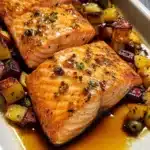
Maple Mustard Salmon recipe
Ingredients
- Salmon Fillet: 1 large, 2-pound fillet. A center-cut fillet is ideal as it has a more even thickness, ensuring consistent cooking. You can use skin-on or skin-off salmon; skin-on has the added benefit of providing a barrier that helps keep the fish incredibly moist.
- Pure Maple Syrup: ¼ cup. It is crucial to use 100% pure maple syrup, not breakfast or pancake syrup. The pure syrup provides a clean, nuanced sweetness and caramelizes beautifully.
- Dijon Mustard: 2 tablespoons. This provides a sharp, tangy, and slightly spicy backbone to the sauce, cutting through the richness of the salmon.
- Whole Grain Mustard: 2 tablespoons. This adds a wonderful, poppy texture and a milder, more rustic mustard flavor that complements the Dijon perfectly.
- Low-Sodium Soy Sauce or Tamari: 1 tablespoon. This is the secret umami weapon, adding a deep, savory saltiness that balances the sweetness of the maple syrup. Use tamari for a gluten-free option.
- Garlic: 3 cloves, minced. Freshly minced garlic provides the best aromatic, savory flavor.
- Olive Oil: 1 tablespoon. This helps the glaze spread and prevents the salmon from sticking.
- Salt and Freshly Ground Black Pepper: To taste.
- Fresh Parsley or Dill: 2 tablespoons, chopped, for garnish. This final touch adds a burst of fresh, herbaceous flavor that brightens the entire dish.
Instructions
First, position a rack in the center of your oven and preheat it to 400°F (200°C). Line a large, rimmed baking sheet with parchment paper or aluminum foil. This step is not just for preventing the salmon from sticking; it makes cleanup an absolute breeze. Take the salmon fillet out of the refrigerator and pat it completely dry on all sides with paper towels. This is a critical step, as a dry surface will allow the salmon to roast and the glaze to adhere properly, rather than just steaming.
Step 2: Make the Maple Mustard Glaze
In a small bowl, whisk together the ¼ cup of pure maple syrup, 2 tablespoons of Dijon mustard, 2 tablespoons of whole grain mustard, 1 tablespoon of soy sauce (or tamari), the 3 minced garlic cloves, and the 1 tablespoon of olive oil. Continue whisking until the glaze is smooth and well combined.
Step 3: Season and Glaze the Salmon
Place the dry salmon fillet on the prepared baking sheet, skin-side down if it has skin. Season the top of the fillet generously with salt and freshly ground black pepper. Spoon or brush about two-thirds of the maple mustard glaze evenly over the top and sides of the salmon. Reserve the remaining one-third of the glaze for later.
Step 4: Bake to Flaky Perfection
Place the baking sheet in the preheated oven and bake for 12-15 minutes. The exact cooking time will depend on the thickness of your salmon fillet. You’ll know it’s done when the flesh is opaque and flakes easily when gently pressed with a fork at the thickest part. For precise results, you can use an instant-read thermometer; the USDA recommends an internal temperature of 145°F, but many chefs and home cooks prefer to pull the salmon out between 130°F and 135°F for a moister, more tender result, as it will continue to cook slightly from residual heat after being removed from the oven.
Step 5: The Final Caramelization (Optional but Highly Recommended)
For that beautiful, bubbly, and caramelized top that makes this dish truly special, you can use the broiler for the final minute of cooking. Remove the salmon from the oven, brush the remaining reserved glaze over the top, and switch your oven setting to a high broil. Return the salmon to the oven on the center rack and broil for 1-2 minutes. Watch it like a hawk during this step, as the sugars in the maple syrup can go from perfectly caramelized to burnt very quickly.
Step 6: Rest and Garnish
Remove the salmon from the oven and let it rest on the baking sheet for 5 minutes. This allows the juices to redistribute throughout the fillet, ensuring every bite is moist and flavorful. After resting, transfer the whole fillet to a serving platter and sprinkle generously with the chopped fresh parsley or dill. Serve immediately.
Nutrition
- Serving Size: one normal portion
- Calories: 350-450

